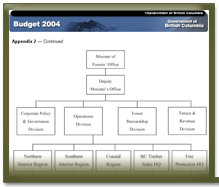 |
|
Appendix 2.Organizational StructureIn response to its refocused mandate and resource reduction requirements, the ministry initiated a significant restructuring in 2002/03. The restructuring aligned available resources with the ministry's core business functions. The Victoria headquarters structure consists of the following major elements: Corporate Policy and Governance Division, Operations Division (Field Services and BC Timber Sales), Forest Stewardship Division, and Tenure and Revenue Division. The field structure of the ministry consists of the following major elements: three forest region offices with 29 forest district offices and four satellite offices; 12 BC Timber Sales offices; and six fire centres.
LegislationThe main statutes for which the Forest Service has responsibility are as follows: Forest and Range Practices Act and Forest Practices Code of British Columbia ActIn November 2002, the Forest and Range Practices Act was introduced. In 2005, this act will completely replace the Forest Practices Code of British Columbia Act. A series of regulations will provide for the transition between the two statutes. The new act is intended to be less process oriented and more results specific. Both acts enable the Forest Service to:
Forest ActThe Forest Act provides the Forest Service with the authority to:
Major changes to the Forest Act during 2003/04 and 2004/05 include:
Ministry of Forests ActThe Ministry of Forests Act continues the Forest Service and provides it with a broad and general mandate to: 1. Encourage maximum resource productivity; 2. Manage resources responsibly to achieve the greatest short and long-term social benefits; 3. Practice planned, integrated resource management and use; 4. Encourage a globally competitive forest industry; and 5. Assert the financial interest of the government. Range ActThe Range Act authorizes the Forest Service to allocate and administer the use of range resources by the livestock industry through grazing and hay-cutting agreements that provide revenue to the government. Wildfire ActIn 2004 a new Wildfire Act is planned to replace the protection provisions currently in the Forest Practices Code of British Columbia Act. The new act and regulations will be more results-based while providing greater regulatory freedom for the forest industry. The new act will still ensure that government retains the authority to fight any fire that threatens forest resources and to restrict access, limit operations and requisition equipment and personnel in the event of significant fire activity. Forestry Revitalization ActThe Forestry Revitalization Act is an integral part of government's forestry revitalization plan. The revitalization plan will open up opportunities for new participants in both forest management and wood processing sectors, communities, First Nations, woodlot owners and entrepreneurs, creating a more diversified and innovative forest sector that is better able to provide employment and wealth. To create these new opportunities, government will reallocate 20 per cent of logging rights from major licensees, which will be added to what is already available on the open market. As a result of these and other changes, up to 45 per cent of the province's total harvest will eventually be available through the open market. One-time funding of $275 million has been set aside for the transition from the old to the new, stronger forest economy. Forest companies will be fairly compensated for the legal harvesting rights removed from their allowable annual cuts; $200 million has been allocated for this purpose. Forest workers and contractors will have access to a $75 million trust fund for transition assistance.
|
|||||||||||||||||||||||||||||
|
||||||||||||||||||||||||||||||

